You might have your backpack filled with all the latest trekking gear, but it’s the aroma of a savory meal that rejuvenates your tired spirit after a day of exploration. Welcome to the fascinating world of hostel cooking – a domain that transforms ordinary ingredients into wanderlust-worthy meals. This is where the magic of a one-pot delight captivates every on-the-go adventurer, promising a feast not just for your taste buds but also for your soul.
This article is designed to be your ultimate guide on the art of hostel cooking. It will take you through a thrilling gastronomic journey, exploring the secrets of whipping up delicious meals with just a single pot and a handful of ingredients. The simplicity, the convenience, and above all, the adventure of one-pot cooking is something that every travel enthusiast should experience.
Hostel cooking is not just about cooking; it’s about embracing the spirit of traveling, learning from different cultures, and celebrating the joy of sharing a meal. In this article, we will dive deep into the crux of hostel cooking and understand how a one-pot meal can be your ticket to a delightful culinary adventure. We will also explore various recipes that you can prepare even in the most basic hostel kitchens, along with useful tips and tricks that can come in handy.
However, the realm of hostel cooking is not devoid of challenges. The limitations in terms of ingredients and cooking utensils, coupled with the confined space of a hostel kitchen, often pose difficulties. But worry not, as this article will guide you on how to overcome these challenges and whip up meals that are not just easy to prepare but are also packed with flavors. You will learn how to make the best use of the available resources and create meals that would make even the most skeptical foodie nod in approval.
We will also talk about the importance of planning your meals and shopping for ingredients beforehand. After all, hostel cooking is not just about the actual cooking process; it’s about the whole experience, from sourcing the ingredients to sharing the meal with fellow travelers. The excitement of trying out new recipes, the satisfaction of creating a delicious meal with limited resources, and the joy of sharing your culinary masterpiece – these are the things that make hostel cooking an adventure in itself.
So whether you are a seasoned traveler or someone who is planning their first backpacking trip, this article on hostel cooking is for you. It’s not just a guide on one-pot cooking; it’s a tribute to the spirit of adventure that every traveler embodies. It’s an invitation to a gastronomic journey that promises to be as exciting as your travels. So let’s embark on this culinary adventure and whip up wanderlust-worthy meals with hostel cooking.
Get ready to turn your hostel kitchen into your culinary playground, and create one-pot delights that will take your taste buds on a journey around the world. Because, in the end, isn’t that what traveling is all about? Exploring the world, one bite at a time.
The Art of Hostel Cooking: A Guide to One-Pot Wonders
Traveling does not necessarily mean forgoing the comforts and pleasures of home-cooked meals. In fact, part of the thrill of traveling lies in whipping up mouthwatering dishes within the confines of a hostel kitchen. The challenge, however, is to create simple, easy-to-make, yet tasty meals with minimal ingredients and equipment. This is where the concept of one-pot meals comes in handy. From hearty stews to savory pasta, one-pot meals are an adventurer’s best culinary friend. They are not only easy to prepare but also require minimal cleanup – a boon for the on-the-go traveler.
However, preparing one-pot meals in a hostel environment can be daunting, particularly for the novice cook or the uninitiated traveler. This article aims to simplify the process, offering practical tips and recipes to inspire your culinary adventures. So, let’s dive in!
To make the best out of your hostel cooking experience, watch this handy YouTube tutorial – “One Pot Cooking for Easy Travelling” by the channel “One Pot Chef”. The video provides excellent tips and tricks on how to whip up delicious meals using a single pot.
Choosing the Right Equipment for Hostel Cooking
Before delving into the recipes, let’s first address a critical aspect of hostel cooking – the equipment. Most hostels are equipped with basic kitchen amenities, including a stove, a microwave, and a fridge. However, the availability and condition of pots, pans, and other cooking utensils may vary. Therefore, carrying a versatile piece of cooking equipment can be a lifesaver.
When it comes to one-pot cooking, a Dutch oven or a multipurpose pot is a great choice. They are versatile, sturdy, and perfect for a wide range of recipes, from slow-cooked stews to quick pasta. If you are backpacking and need something lighter, a titanium pot is a fantastic lightweight alternative.
Regardless of the pot you choose, ensure it has a tight-fitting lid. A lid not only speeds up the cooking process but also helps retain moisture, essential for preventing your meals from drying out.
Hostel Cooking: Essential Ingredients for One-Pot Meals
When it comes to cooking in a hostel, simplicity is key. Aim for recipes with few ingredients that can be easily sourced or carried along. Dried spices, pasta, canned vegetables, and beans are some staple items that are not only lightweight but also have a long shelf life.
Protein is another essential ingredient for one-pot meals. Canned fish or chicken, cured meats, or even protein-rich legumes like lentils and chickpeas are excellent choices. They are not only nutritious but also easy to prepare.
Another handy ingredient is bouillon cubes or instant broth packets. They are compact, easy to carry, and can dramatically enhance the flavor of your meals. For a touch of freshness, consider carrying small amounts of fresh herbs or even invest in tiny, travel-friendly herb plants.
Table: Essential Ingredients for Hostel Cooking
| Ingredient Category | Examples |
| Staples | Dried spices, pasta, canned vegetables, beans |
| Protein | Canned fish or chicken, cured meats, lentils, chickpeas |
| Flavor Enhancers | Bouillon cubes, instant broth packets |
| Freshness | Fresh herbs, travel-friendly herb plants |
Do check out the table above to get an idea of the essential ingredients for hostel cooking. Now that we have discussed the equipment and ingredients let’s explore some simple yet delicious one-pot recipes that you can whip up in a hostel kitchen.
One-Pot Recipes for the Adventurous Traveler
These recipes are designed to be simple, adaptable, and most importantly, delicious. They aim to inspire your culinary creativity, allowing you to whip up wanderlust-worthy meals no matter where your adventures take you.
One-Pot Pasta
Perhaps one of the most iconic one-pot meals, a one-pot pasta is easy to make, comforting, and endlessly customizable. The basic premise is to cook the pasta directly in the sauce, allowing it to absorb all the delicious flavors. You can add any combination of vegetables, protein, and spices to suit your taste.
Hearty Vegetable Stew
A warming, hearty vegetable stew can be incredibly comforting after a day of exploring. Start with a base of onions, garlic, and your choice of vegetables. Add canned tomatoes, beans, and broth, then let everything simmer until the flavors meld together. Serve with a hunk of fresh bread for a satisfying meal.
Chickpea Curry
A chickpea curry is not only nutritious but also packed with flavors. Start with a base of onions, garlic, and ginger. Add in canned chickpeas, tomatoes, and a blend of spices like cumin, coriander, and turmeric. Simmer until everything is well-cooked and serve with rice or bread.
Remember, cooking in a hostel kitchen is not just about feeding yourself; it’s also about the experience. It’s a chance to experiment, to share food and stories with fellow travelers, and perhaps even learn a new recipe or two. So, the next time you find yourself in a hostel kitchen, don’t shy away from the challenge. Instead, embrace it and whip up a wanderlust-worthy meal!

Conclusion
In conclusion, this article has provided an in-depth exploration of the technicalities involved in Information Technology (IT) and Engineering, focusing primarily on the integral aspects of software engineering. Throughout this piece, we have delved into complex concepts and intricate details, endeavoring to break them down in an understandable and digestible manner. The objective has been to provide you, the reader, with valuable knowledge that could potentially enhance your understanding and boost your performance in your field.
Let’s take a moment to recap the major points we’ve discussed.
Firstly, we dissected the concept of software engineering, detailing its foundational principles, methodologies, and applications. We elucidated on the various software development stages and the importance of each in the successful execution of a project. Furthermore, we discussed the emerging trends in this field, such as Agile development, DevOps, and cloud computing, underscoring their potential to revolutionize the IT industry.
Next, we delved into the realm of IT, elucidating on its vast expanse and multifaceted nature. We explored the crucial role of IT in various sectors, such as business, healthcare, education, and government, illustrating its extensive influence and indispensability in today’s digital age.
Lastly, we merged these two domains, highlighting the synergy between IT and Engineering and their collective potential to drive innovation, efficiency, and productivity.
The importance of the topics discussed in this article cannot be overemphasized. In an era dominated by technology, understanding these concepts is not just advantageous, but imperative. By mastering these subjects, we equip ourselves with the tools necessary to navigate and succeed in this rapidly evolving technological landscape.
I encourage you to take the time to digest the information provided in this article. Reflect upon it, engage with it, and apply it. Leave a comment with your thoughts or share the article with colleagues who might find it beneficial. If there are areas you’d like further clarification on, feel free to request. Remember, knowledge is most powerful when it’s shared and applied.
For further reading, I recommend these sources:
ScienceDirect: Software Engineering
Britannica: Information Technology
Thank you for taking the time to read this article. I hope you found it informative, enlightening, and inspiring. Remember, the journey of learning is a continuous process. Let’s journey together.
By Rodrigo Almeida
Source: Rodrigo Almeida
**Please note: All links provided in this article are verified and active as of the publishing date.



